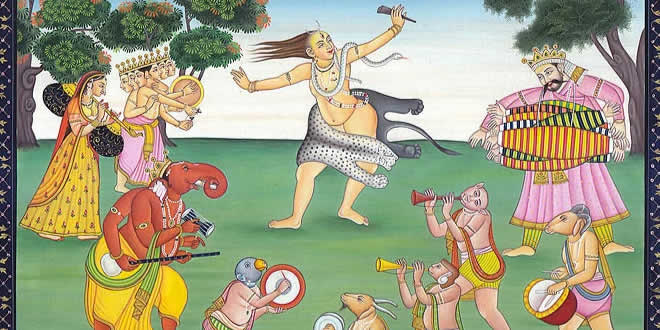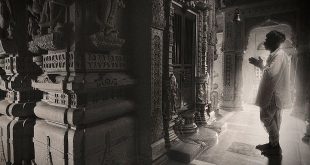What is Shiva Tandava? Lord Shiva is also known as Nataraj, the Dancing God. This divine art form is performed by Lord Shiva and his divine consort Goddess Parvati. The dance performed by Lord Shiva is known as Tandava. Shiva’s Tandava is a vigorous dance that is the source of the cycle of creation, preservation and dissolution. Tandava depicts his violent nature as the destroyer of the universe.
Characteristics of Tandava Dance
According to scholars, ‘Characteristics of the Tandava Dance‘ have been described in the fourth chapter of Bharat Muni’s Nata Shastra, which is referred to as fifth Veda and an expression of Lord Shiva’s eternal dance – Tandava. It says that Shiva’s Tandava is embellished with 108 karanas and the 32 anghaharas – the composite parts of the dance. Bharat Muni further says that Lord Shiva conceived the dance, as he was very much fond of dancing every evening. Shiva further mentioned that 108 karnas included in tandava could be employed in the course of dance, fight, and personal combats and in other special movements like strolling.
Types of Tandava
Some scholars believe that there are seven different types of Tandava. The tandava performed with joy is called Ananda Tandava and that which is performed in violent mood is called Rudra Tandava. The other types of tandava identified are Tripura Tandava, Sandhya Tandava, Samara Tandava, Kaali Tandava, Uma Tandava and Gauri Tandava. However, there are few people who believe that there are 16 types of Tandava.
Significance of Shiva’s Tandava Nritya
According to religious scholars, the cosmic dance of Shiva, called ‘Anandatandava’, meaning, ‘the Dance of Bliss’ symbolizes the cosmic cycles of creation and destruction, as well as the daily rhythm of birth and death. The dance is a pictorial allegory of the five principle manifestations of eternal energy – creation, destruction, preservation, salvation and illusion.
According to learned scholar, Coomerswamy, the dance of Shiva also represents his five activities namely,
- ‘Shrishti‘ – creation, evolution
- ‘Sthiti‘ – preservation, support
- ‘Samhara‘ – destruction, evolution
- ‘Tirobhava‘ – illusion
- ‘Anugraha‘ – release, emancipation, grace
The overall temper of the image is paradoxical, uniting the inner tranquility, and outside activity of Shiva.
Lasya
The dance performed by Goddess Parvati is known as Lasya. In Lasya, the movements are gentle, graceful and sometimes erotic. Some scholars call Lasya, the feminine version of Tandava. Lasya is of two kinds – Jarita Lasya and Yauvaka Lasya. According to the Puranas, Shiva dances a wild and vigorous (tandava) dance in the cremation grounds at night but dances a soft and graceful (lasya) dance in the tranquility of the twilight.
Shiva Tandava Stotram in Hindi
जटाटवीगलज्जलप्रवाहपावितस्थले
गलेऽवलम्ब्य लम्बितां भुजङ्गतुङ्गमालिकाम् |
डमड्डमड्डमड्डमन्निनादवड्डमर्वयं
चकार चण्डताण्डवं तनोतु नः शिवः शिवम् ||१||
जटाकटाहसम्भ्रमभ्रमन्निलिम्पनिर्झरी
विलोलवीचिवल्लरीविराजमानमूर्धनि |
धगद्धगद्धगज्ज्वलल्ललाटपट्टपावके
किशोरचन्द्रशेखरे रतिः प्रतिक्षणं मम ||२||
धराधरेन्द्रनंदिनीविलासबन्धुबन्धुर
स्फुरद्दिगन्तसन्ततिप्रमोदमानमानसे |
कृपाकटाक्षधोरणीनिरुद्धदुर्धरापदि
क्वचिच्चिदम्बरे मनो विनोदमेतु वस्तुनि ||३||
जटाभुजङ्गपिङ्गलस्फुरत्फणामणिप्रभा
कदम्बकुङ्कुमद्रवप्रलिप्तदिग्वधूमुखे |
मदान्धसिन्धुरस्फुरत्त्वगुत्तरीयमेदुरे
मनो विनोदमद्भुतं बिभर्तु भूतभर्तरि ||४||
सहस्रलोचनप्रभृत्यशेषलेखशेखर
प्रसूनधूलिधोरणी विधूसराङ्घ्रिपीठभूः |
भुजङ्गराजमालया निबद्धजाटजूटक
श्रियै चिराय जायतां चकोरबन्धुशेखरः ||५||
ललाटचत्वरज्वलद्धनञ्जयस्फुलिङ्गभा
निपीतपञ्चसायकं नमन्निलिम्पनायकम् |
सुधामयूखलेखया विराजमानशेखरं
महाकपालिसम्पदेशिरोजटालमस्तु नः ||६||
करालभालपट्टिकाधगद्धगद्धगज्ज्वल
द्धनञ्जयाहुतीकृतप्रचण्डपञ्चसायके |
धराधरेन्द्रनन्दिनीकुचाग्रचित्रपत्रक
प्रकल्पनैकशिल्पिनि त्रिलोचने रतिर्मम ||७||
नवीनमेघमण्डली निरुद्धदुर्धरस्फुरत्
कुहूनिशीथिनीतमः प्रबन्धबद्धकन्धरः |
निलिम्पनिर्झरीधरस्तनोतु कृत्तिसिन्धुरः
कलानिधानबन्धुरः श्रियं जगद्धुरंधरः ||८||
प्रफुल्लनीलपङ्कजप्रपञ्चकालिमप्रभा
वलम्बिकण्ठकन्दलीरुचिप्रबद्धकन्धरम् |
स्मरच्छिदं पुरच्छिदं भवच्छिदं मखच्छिदं
गजच्छिदांधकच्छिदं तमन्तकच्छिदं भजे ||९||
अखर्व(अगर्व) सर्वमङ्गलाकलाकदम्बमञ्जरी
रसप्रवाहमाधुरी विजृम्भणामधुव्रतम् |
स्मरान्तकं पुरान्तकं भवान्तकं मखान्तकं
गजान्तकान्धकान्तकं तमन्तकान्तकं भजे ||१०||
जयत्वदभ्रविभ्रमभ्रमद्भुजङ्गमश्वस
द्विनिर्गमत्क्रमस्फुरत्करालभालहव्यवाट् |
धिमिद्धिमिद्धिमिध्वनन्मृदङ्गतुङ्गमङ्गल
ध्वनिक्रमप्रवर्तित प्रचण्डताण्डवः शिवः ||११||
दृषद्विचित्रतल्पयोर्भुजङ्गमौक्तिकस्रजोर्
गरिष्ठरत्नलोष्ठयोः सुहृद्विपक्षपक्षयोः |
तृणारविन्दचक्षुषोः प्रजामहीमहेन्द्रयोः
समं प्रव्रितिक: कदा सदाशिवं भजाम्यहम ||१२||
कदा निलिम्पनिर्झरीनिकुञ्जकोटरे वसन्
विमुक्तदुर्मतिः सदा शिरः स्थमञ्जलिं वहन् |
विमुक्तलोललोचनो ललामभाललग्नकः
शिवेति मंत्रमुच्चरन् कदा सुखी भवाम्यहम् ||१३||
निलिम्प नाथनागरी कदम्ब मौलमल्लिका-
निगुम्फनिर्भक्षरन्म धूष्णिकामनोहरः ।
तनोतु नो मनोमुदं विनोदिनींमहनिशं
परिश्रय परं पदं तदङ्गजत्विषां चयः ॥१४॥
प्रचण्ड वाडवानल प्रभाशुभप्रचारणी
महाष्टसिद्धिकामिनी जनावहूत जल्पना ।
विमुक्त वाम लोचनो विवाहकालिकध्वनिः
शिवेति मन्त्रभूषगो जगज्जयाय जायताम् ॥१५॥
इमं हि नित्यमेवमुक्तमुत्तमोत्तमं स्तवं
पठन्स्मरन्ब्रुवन्नरो विशुद्धिमेतिसंततम् |
हरे गुरौ सुभक्तिमाशु याति नान्यथा गतिं
विमोहनं हि देहिनां सुशङ्करस्य चिंतनम् ||१६||
पूजावसानसमये दशवक्त्रगीतं
यः शम्भुपूजनपरं पठति प्रदोषे |
तस्य स्थिरां रथगजेन्द्रतुरङ्गयुक्तां
लक्ष्मीं सदैव सुमुखिं प्रददाति शम्भुः ||१७||
 Kids Portal For Parents India Kids Network
Kids Portal For Parents India Kids Network







